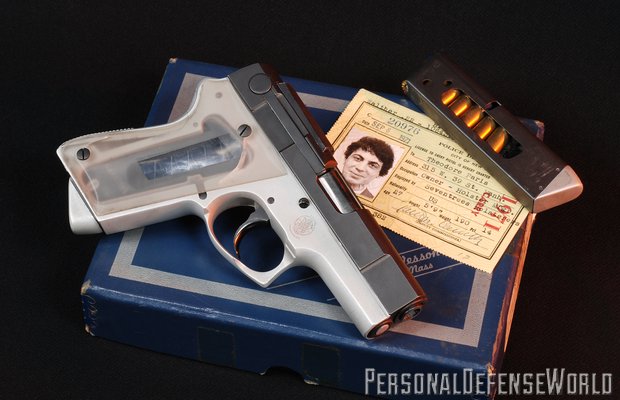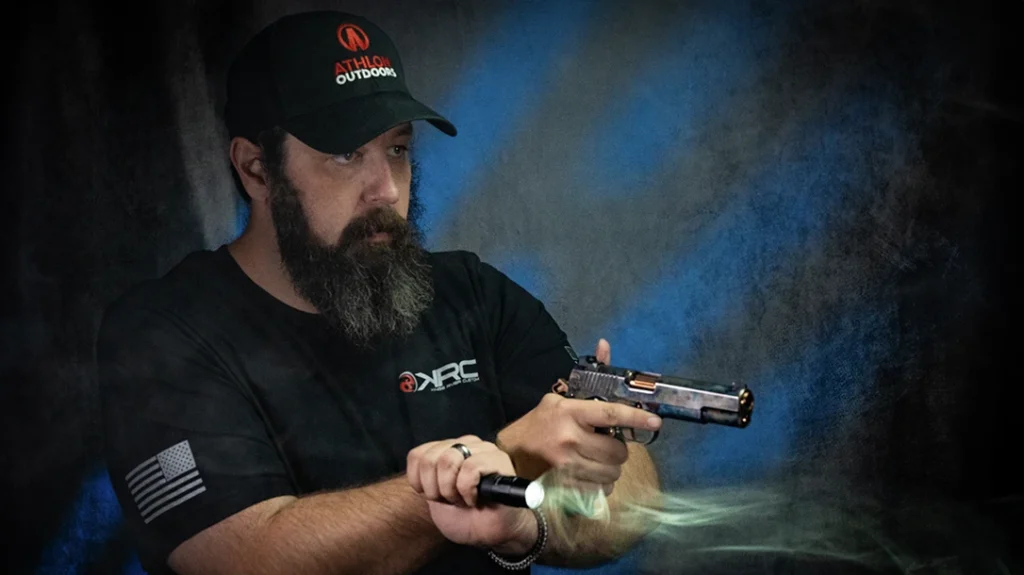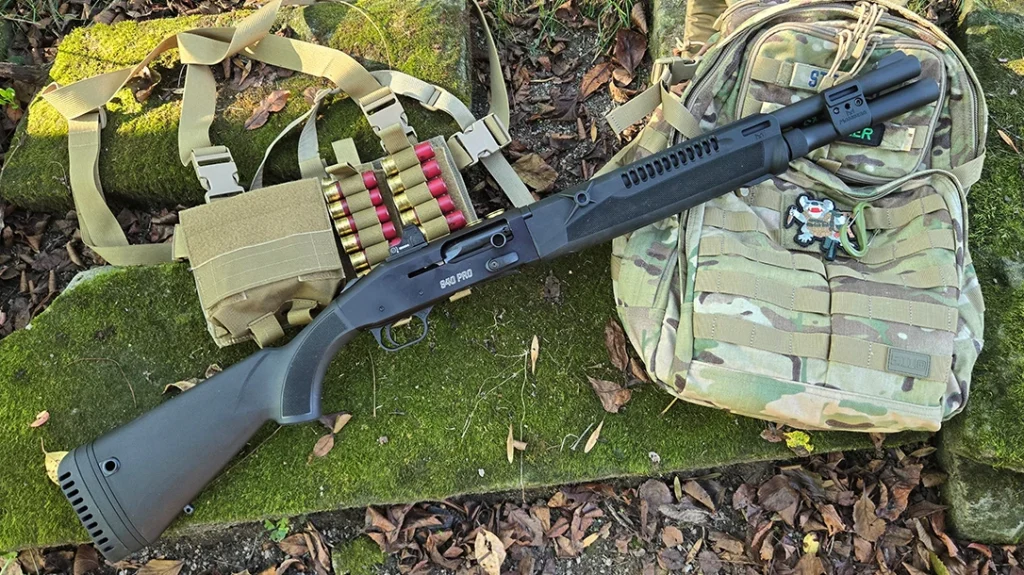There was a time in the not so distant past when the world was a smaller place. The Cold War was hot, the threat was real, and the battles were fought on a daily basis from New York to Moscow. There was no internet or blogs, and those who were in the know didn’t share their knowledge with those who weren’t. The term “dangerous men” was a compliment to those who lived and fought in the shadows. These men roamed the world, armed with exotic weapons that were only discussed in closed circles. It was the time of the modern gunfighter and the birth of the ASP.
The story of the ASP reads like a Ludlum or Flynn novel. In 1966, a young Paris Theodore founded custom-holster company Seventrees Ltd. Located in New York City on West 39th Street, Seventrees designed and produced “modern” concealment holsters for professionals. The company’s clientele ranged from NYPD detectives to “spooks” from many countries. Documents show that Seventrees was awarded several contracts from a variety of U.S. agencies, including an order for handcuff cases from the U.S. Secret Service.
The holster business, while both legitimate and profitable, was only part of the story. Located in the backroom behind a vault door, Seventrees’ sister company, Armament Systems and Procedures (ASP), was a clandestine laboratory that worked with various government organizations to design and produce specialized weapons. Company archives show that, in May of 1971, Theodore delivered a “special experimental submachine gun” to the U.S. Army’s Frankfort Arsenal with a “special sight,” shoulder holster and belt holster. However, the most lasting project was the ASP pistol.
Advertisement — Continue Reading Below
According to Theodore, the ASP was developed on behalf of a government agency that needed a concealable handgun chambered in a “major caliber.” During the early development, various 1911s and Browning Hi-Powers were cut down and reconfigured. But in each case, the end result was lacking.
Revamped M39
For the ASP’s base platform, Theodore finally settled on the Smith & Wesson Model 39, which was introduced in 1954 to compete in the U.S. Army service-pistol trials and offered to the commercial market in 1955. The M39 featured an aluminum frame, a 4-inch barrel and a Walther-style, double-action fire control system. The weapon was chambered in 9mm Parabellum and had an eight-round magazine capacity. The M39’s most notable feature was the one-piece, deeply curved backstrap. To this day, the M39 fits my hand better than any pistol I’ve ever owned.
Advertisement — Continue Reading Below
The ASP was the result of some 212 modifications to the stock M39. The most dramatic modifications were the reductions in the slide and frame. The slide and barrel were shortened by 0.75 inches, while the butt of the frame was reduced by 0.56 inches. These changes in turn required extensive internal modifications to the barrel bushing, recoil spring and guide, as well as the mainspring and backstrap assembly. To lighten the slide, the muzzle end was tapered and the rear cocking serrations were removed. To further reduce the size, the hammer spur was removed and the thumb safety was shaved. Each pistol came with three shortened magazines that featured a patented finger-rest baseplate.
Another striking feature of the ASP was its uniquely shaped triggerguard. The standard triggerguard was cut, and a hooked extension was heliarc-welded onto the pistol using a comparable alloy. The design was patented as a “forefinger pocket” and aided in a finger-forward, two-handed grip. For improved access, the forward half of the triggerguard was reduced in width by 50 percent—a change that tailored to right- and left-handed shooters.
The ASPs sighting system was revolutionary. Theodore’s patented sight, called the Guttersnipe, consisted of a machined block of steel with a tapered, longitudinal channel. The sides and bottom of the sight channel were painted yellow for greater visibility, and there was no front sight. The Guttersnipe required the shooter to subconsciously balance the yellow panels on the sides and the bottom of the channel to align the ASP properly. In practice, the Guttersnipe was battle-accurate and extremely fast to acquire.
Advertisement — Continue Reading Below
Theodore also understood that it was rare for anyone involved in a violent encounter to keep track of the number of rounds that were expended. To that end, he cut a large witness window in both sides of the magazines and equipped the ASP with clear Lexan grip panels. Shooters could now see how many rounds were in the magazine.
The ASP’s entire design was focused on the rapidly changing dynamic in a moving gunfight. As Theodore said, “Our mission was to create a major-caliber weapon which was readily concealable yet could be brought into action with ‘the speed of an impulse.’” That was pretty shocking in 1970! Every edge of the ASP was radiused, and it was void of any textured gripping surfaces. The shape of the grip and triggerguard is what seated the pistol in the hand during a panic draw.
Covert Ops
Advertisement — Continue Reading Below
The ASP was specifically designed to engage and neutralize threats. How effective was the design? According to several reliable sources, during a demonstration, an intelligence officer was able to draw the ASP from concealment and engage a target at 7 yards with 22 rounds (which included two reloads) in 7 seconds. And all of the shots could be covered by the palm of one hand!
The earliest ASP article I could find was written by noted author George Nonte in the February 1971 issue of Guns. The article covers the development of the pistol and goes into detail about ammunition selection, including Canadian 9mm submachine gun ammo and two Super Vel loads. Nonte reported that the 112-grain JSP load chronographed 1,223 feet per second (fps), and the hot 90-grain JHP chronographed at 1,430 fps. In another article by Nonte in 1972, an early ASP was shown with a black slide, matte gray frame and trimmed factory stocks. At the time of the article, anyone wanting an ASP was required to provide a serviceable Model 39, and the conversion fee was $225.
The fact that Nonte had access to the early guns was somewhat of a mystery until I discovered that Nonte was Theodore’s partner in the ASP project. Documents show that Nonte not only aided in the development and testing of the ASP but also was directly involved in the manufacturing process. Correspondence between Theodore and Nonte lists each gun by serial number sent to Nonte for the conversion. It appears that the two had a falling out and terminated the agreement in the early ’70s.
Advertisement — Continue Reading Below
Theodore provided samples to various government agencies, and the ASP became something of an enigma as well as a status symbol. While the articles had placed the pistol in the public’s eye, the majority of end-users were quiet professionals. In a Combat Handguns article, Theodore wrote that the commanding officer of the American Embassy security detail in Saigon carried an ASP. He also mentioned that there were several full-automatic and low-signature versions in the hands of intelligence operatives. Company archives also show a line drawing of a detachable shoulder stock that was being considered.
ASP Legacy
While Theodore was creative in his own right, sources report that his business practices were not always sound—he made substantial enemies. This, along with other issues, resulted in Seventrees and ASP closing their doors in the mid to late ’70s. The Seventrees line of holsters was purchased by Ken Null, who still offers many of the original Seventrees designs. For more information, visit klnullholsters.com or call 706-625-5643.
Advertisement — Continue Reading Below
Kevin Parsons purchased Armament Systems and Procedures and produced the ASP pistol for several years. Parsons is attributed with taking the design and applying modern machining processes to the conversions. These second-generation pistols are marked “ASP, Appleton, WI” and were considerably cleaner than the New York guns. The most notable change involved making the Guttersnipe from injection-molded polymer.
Parris Theodore died on November 16, 2007, at the age of 63. His obituary in the Wall Street Journal described him as the “Real-Life Q” and describes Theodore’s 1975 appearance before the U.S. Senate committee investigating the Central Intelligence Agency. The ASP 9mm lives on as one of the most unique firearms developed for covert operations in the Cold War.
























